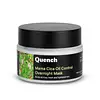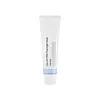What's inside
What's inside
 Key Ingredients
Key Ingredients

 Benefits
Benefits

 Concerns
Concerns

 Ingredients Side-by-side
Ingredients Side-by-side

Water
Skin ConditioningButylene Glycol
HumectantGlycereth-26
HumectantCaprylic/Capric Triglyceride
Masking1,2-Hexanediol
Skin ConditioningGlycerin
HumectantNiacinamide
SmoothingHydrogenated Polydecene
EmollientHydrogenated Lecithin
EmulsifyingPolyacrylate Crosspolymer-6
Emulsion StabilisingGlyceryl Stearate
EmollientCetearyl Alcohol
EmollientAmmonium Acryloyldimethyltaurate/Vp Copolymer
Panthenol
Skin ConditioningBehenic Acid
CleansingBehenyl Alcohol
EmollientStearic Acid
CleansingStearyl Alcohol
EmollientAllantoin
Skin ConditioningDipotassium Glycyrrhizate
HumectantMyristic Acid
CleansingEthylhexylglycerin
Skin ConditioningCalophyllum Inophyllum Seed Oil
AntimicrobialRosmarinus Officinalis Leaf Oil
MaskingCalendula Officinalis Flower Extract
MaskingCentella Asiatica Extract
CleansingNelumbo Nucifera Root Extract
Skin ConditioningPanax Ginseng Root Extract
EmollientCaramel
Cosmetic ColorantWater, Butylene Glycol, Glycereth-26, Caprylic/Capric Triglyceride, 1,2-Hexanediol, Glycerin, Niacinamide, Hydrogenated Polydecene, Hydrogenated Lecithin, Polyacrylate Crosspolymer-6, Glyceryl Stearate, Cetearyl Alcohol, Ammonium Acryloyldimethyltaurate/Vp Copolymer, Panthenol, Behenic Acid, Behenyl Alcohol, Stearic Acid, Stearyl Alcohol, Allantoin, Dipotassium Glycyrrhizate, Myristic Acid, Ethylhexylglycerin, Calophyllum Inophyllum Seed Oil, Rosmarinus Officinalis Leaf Oil, Calendula Officinalis Flower Extract, Centella Asiatica Extract, Nelumbo Nucifera Root Extract, Panax Ginseng Root Extract, Caramel
Centella Asiatica Leaf Water
Skin ConditioningButylene Glycol
HumectantHelianthus Annuus Seed Oil
EmollientGlycerin
HumectantBetaine
HumectantPanthenol
Skin ConditioningCetearyl Alcohol
EmollientDimethicone
EmollientElaeis Guineensis Oil
EmollientElaeis Guineensis Kernel Oil
EmollientBeeswax
Emulsion StabilisingGluconolactone
Skin ConditioningHydroxyethyl Acrylate/Sodium Acryloyldimethyl Taurate Copolymer
Emulsion StabilisingCetearyl Olivate
Sorbitan Olivate
EmulsifyingCaprylic/Capric Triglyceride
Masking1,2-Hexanediol
Skin ConditioningBetaine Salicylate
AntimicrobialEthylhexylglycerin
Skin ConditioningLactic Acid
BufferingWater
Skin ConditioningNiacinamide
SmoothingXanthan Gum
EmulsifyingSodium Hydroxide
BufferingEthyl Hexanediol
SolventMelaleuca Alternifolia Leaf Oil
AntioxidantCentella Asiatica Leaf Water, Butylene Glycol, Helianthus Annuus Seed Oil, Glycerin, Betaine, Panthenol, Cetearyl Alcohol, Dimethicone, Elaeis Guineensis Oil, Elaeis Guineensis Kernel Oil, Beeswax, Gluconolactone, Hydroxyethyl Acrylate/Sodium Acryloyldimethyl Taurate Copolymer, Cetearyl Olivate, Sorbitan Olivate, Caprylic/Capric Triglyceride, 1,2-Hexanediol, Betaine Salicylate, Ethylhexylglycerin, Lactic Acid, Water, Niacinamide, Xanthan Gum, Sodium Hydroxide, Ethyl Hexanediol, Melaleuca Alternifolia Leaf Oil
Ingredients Explained
These ingredients are found in both products.
Ingredients higher up in an ingredient list are typically present in a larger amount.
1,2-Hexanediol is a synthetic liquid and another multi-functional powerhouse.
It is a:
- Humectant, drawing moisture into the skin
- Emollient, helping to soften skin
- Solvent, dispersing and stabilizing formulas
- Preservative booster, enhancing the antimicrobial activity of other preservatives
Butylene Glycol (or BG) is used within cosmetic products for a few different reasons:
Overall, Butylene Glycol is a safe and well-rounded ingredient that works well with other ingredients.
Though this ingredient works well with most skin types, some people with sensitive skin may experience a reaction such as allergic rashes, closed comedones, or itchiness.
Learn more about Butylene GlycolThis ingredient is an emollient, solvent, and texture enhancer. It is considered a skin-softener by helping the skin prevent moisture loss.
It helps thicken a product's formula and makes it easier to spread by dissolving clumping compounds.
Caprylic Triglyceride is made by combining glycerin with coconut oil, forming a clear liquid.
While there is an assumption Caprylic Triglyceride can clog pores due to it being derived from coconut oil, there is no research supporting this.
Learn more about Caprylic/Capric TriglycerideCetearyl alcohol is a mixture of two fatty alcohols: cetyl alcohol and stearyl alcohol. It is mainly used as an emulsifier. Emulsifiers help prevent the separation of oils and products. Due to its composition, it can also be used to thicken a product or help create foam.
Cetearyl alcohol is an emollient. Emollients help soothe and hydrate the skin by trapping moisture.
Studies show Cetearyl alcohol is non-toxic and non-irritating. The FDA allows products labeled "alcohol-free" to have fatty alcohols.
This ingredient is usually derived from plant oils such as palm, vegetable, or coconut oils. There is debate on whether this ingredient will cause acne.
Due to the fatty acid base, this ingredient may not be Malassezia folliculitis safe.
Learn more about Cetearyl AlcoholEthylhexylglycerin (we can't pronounce this either) is commonly used as a preservative and skin softener. It is derived from glyceryl.
You might see Ethylhexylglycerin often paired with other preservatives such as phenoxyethanol. Ethylhexylglycerin has been found to increase the effectiveness of these other preservatives.
Glycerin is already naturally found in your skin. It helps moisturize and protect your skin.
A study from 2016 found glycerin to be more effective as a humectant than AHAs and hyaluronic acid.
As a humectant, it helps the skin stay hydrated by pulling moisture to your skin. The low molecular weight of glycerin allows it to pull moisture into the deeper layers of your skin.
Hydrated skin improves your skin barrier; Your skin barrier helps protect against irritants and bacteria.
Glycerin has also been found to have antimicrobial and antiviral properties. Due to these properties, glycerin is often used in wound and burn treatments.
In cosmetics, glycerin is usually derived from plants such as soybean or palm. However, it can also be sourced from animals, such as tallow or animal fat.
This ingredient is organic, colorless, odorless, and non-toxic.
Glycerin is the name for this ingredient in American English. British English uses Glycerol/Glycerine.
Learn more about GlycerinNiacinamide is a multitasking form of vitamin B3 that strengthens the skin barrier, reduces pores and dark spots, regulates oil, and improves signs of aging.
And the best part? It's gentle and well-tolerated by most skin types, including sensitive and reactive skin.
You might have heard of "niacin flush", or the reddening of skin that causes itchiness. Niacinamide has not been found to cause this.
In very rare cases, some individuals may not be able to tolerate niacinamide at all or experience an allergic reaction to it.
If you are experiencing flaking, irritation, and dryness with this ingredient, be sure to double check all your products as this ingredient can be found in all categories of skincare.
When incorporating niacinamide into your routine, look out for concentration amounts. Typically, 5% niacinamide provides benefits such as fading dark spots. However, if you have sensitive skin, it is better to begin with a smaller concentration.
When you apply niacinamide to your skin, your body converts it into nicotinamide adenine dinucleotide (NAD). NAD is an essential coenzyme that is already found in your cells as "fuel" and powers countless biological processes.
In your skin, NAD helps repair cell damage, produce new healthy cells, support collagen production, strengthen the skin barrier, and fight environmental stressors (like UV and pollution).
Our natural NAD levels start to decline with age, leading to slower skin repair, visible aging, and a weaker skin barrier. By providing your skin niacinamide, you're recharging your skin's NAD levels. This leads to stronger, healthier, and younger looking skin.
Another name for vitamin B3 is nicotinamide. This vitamin is water-soluble and our bodies don't store it. We obtain Vitamin B3 from either food or skincare. Meat, fish, wheat, yeast, and leafy greens contain vitamin B3.
The type of niacinamide used in skincare is synthetically created.
Learn more about NiacinamidePanthenol is a common ingredient that helps hydrate and soothe the skin. It is found naturally in our skin and hair.
There are two forms of panthenol: D and L.
D-panthenol is also known as dexpanthenol. Most cosmetics use dexpanthenol or a mixture of D and L-panthenol.
Panthenol is famous due to its ability to go deeper into the skin's layers. Using this ingredient has numerous pros (and no cons):
Like hyaluronic acid, panthenol is a humectant. Humectants are able to bind and hold large amounts of water to keep skin hydrated.
This ingredient works well for wound healing. It works by increasing tissue in the wound and helps close open wounds.
Once oxidized, panthenol converts to pantothenic acid. Panthothenic acid is found in all living cells.
This ingredient is also referred to as pro-vitamin B5.
Learn more about PanthenolWater. It's the most common cosmetic ingredient of all. You'll usually see it at the top of ingredient lists, meaning that it makes up the largest part of the product.
So why is it so popular? Water most often acts as a solvent - this means that it helps dissolve other ingredients into the formulation.
You'll also recognize water as that liquid we all need to stay alive. If you see this, drink a glass of water. Stay hydrated!
Learn more about Water